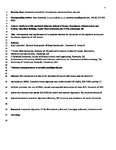Development and optimization of a standard method for extraction of microplastics in mussels by enzyme digestion of soft tissues
| dc.contributor.author | Catarino, AI | |
| dc.contributor.author | Thompson, Richard | |
| dc.contributor.author | Sanderson, W | |
| dc.contributor.author | Henry, TB | |
| dc.date.accessioned | 2016-12-22T14:54:48Z | |
| dc.date.issued | 2017-10-20 | |
| dc.identifier.issn | 0730-7268 | |
| dc.identifier.issn | 1552-8618 | |
| dc.identifier.uri | http://hdl.handle.net/10026.1/8166 | |
| dc.description.abstract |
<jats:title>Abstract</jats:title><jats:sec><jats:label /><jats:p>The authors compared procedures for digestion of mussel soft tissues and extraction of microplastics. Complete tissue digestion was achieved with 1M NaOH, 35% HNO<jats:sub>3</jats:sub>, and protease at 9.6 UHb/mL (unit hemoglobin per mL); but use of HNO<jats:sub>3</jats:sub> caused unacceptable destruction of some microplastics. Recovery of microplastics spiked into mussels was similar (93 ± 10%) for NaOH and enzyme digestions. The authors recommend use of industrial enzymes based on digestion efficiency, microplastic recovery, and avoidance of caustic chemicals. <jats:italic>Environ Toxicol Chem</jats:italic> 2017;36:947–951. © 2016 SETAC</jats:p></jats:sec> | |
| dc.format.extent | 947-951 | |
| dc.format.medium | Print-Electronic | |
| dc.language | en | |
| dc.language.iso | en | |
| dc.publisher | Wiley | |
| dc.subject | Enzymatic digestion | |
| dc.subject | Fourier transform infrared (FT-IR) | |
| dc.subject | Microplastics | |
| dc.subject | Mussels | |
| dc.subject | Emerging pollutants | |
| dc.subject | Environmental toxicology | |
| dc.title | Development and optimization of a standard method for extraction of microplastics in mussels by enzyme digestion of soft tissues | |
| dc.type | journal-article | |
| dc.type | Journal Article | |
| plymouth.author-url | https://www.webofscience.com/api/gateway?GWVersion=2&SrcApp=PARTNER_APP&SrcAuth=LinksAMR&KeyUT=WOS:000398190000016&DestLinkType=FullRecord&DestApp=ALL_WOS&UsrCustomerID=11bb513d99f797142bcfeffcc58ea008 | |
| plymouth.issue | 4 | |
| plymouth.volume | 36 | |
| plymouth.publication-status | Published | |
| plymouth.journal | Environmental Toxicology and Chemistry | |
| dc.identifier.doi | 10.1002/etc.3608 | |
| plymouth.organisational-group | /Plymouth | |
| plymouth.organisational-group | /Plymouth/Faculty of Science and Engineering | |
| plymouth.organisational-group | /Plymouth/Faculty of Science and Engineering/School of Biological and Marine Sciences | |
| plymouth.organisational-group | /Plymouth/REF 2021 Researchers by UoA | |
| plymouth.organisational-group | /Plymouth/REF 2021 Researchers by UoA/UoA07 Earth Systems and Environmental Sciences | |
| plymouth.organisational-group | /Plymouth/Research Groups | |
| plymouth.organisational-group | /Plymouth/Research Groups/Marine Institute | |
| plymouth.organisational-group | /Plymouth/Users by role | |
| plymouth.organisational-group | /Plymouth/Users by role/Academics | |
| plymouth.organisational-group | /Plymouth/Users by role/Researchers in ResearchFish submission | |
| dc.publisher.place | United States | |
| dcterms.dateAccepted | 2016-08-30 | |
| dc.rights.embargodate | 2017-9-1 | |
| dc.identifier.eissn | 1552-8618 | |
| dc.rights.embargoperiod | Not known | |
| rioxxterms.versionofrecord | 10.1002/etc.3608 | |
| rioxxterms.licenseref.uri | http://www.rioxx.net/licenses/all-rights-reserved | |
| rioxxterms.licenseref.startdate | 2017-10-20 | |
| rioxxterms.type | Journal Article/Review |


